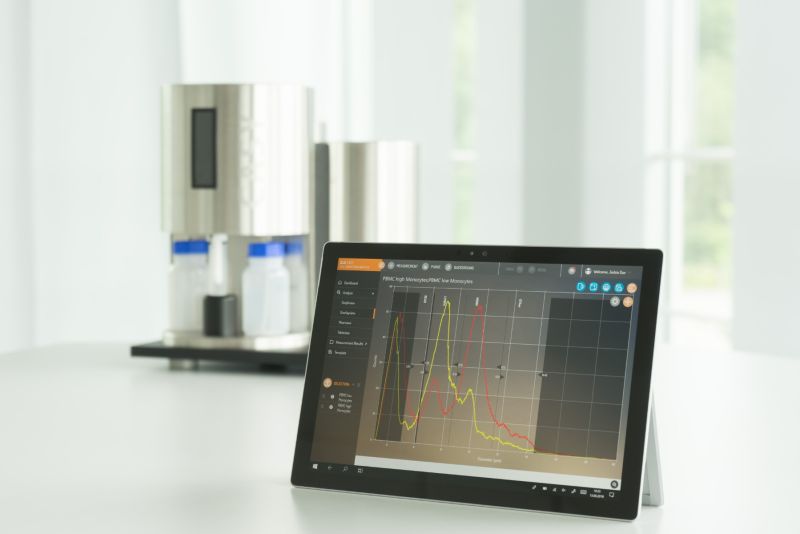CASY Cell Counter & Analyser
CASY Cell Counter & Analyser
Globally, thousands of users, industrial and academic, trust CASY, the legend in cell counting. Whether working with mammalian cells, yeast, bacteria or one of many other cell types, CASY users rely on the unmatched precision, reproducibility and accuracy of the instrument combined with easy and intuitive use.
Highlights
- Simple – No staining or sample preparation
- Fast – Results in as little as 10 secs
- Unique – cell volume based detection and aggregation correction
- Reliable – highest reproducibility even in critical applications (PBMC, Cell- & Immunotherapy, stem cell research, biomanufacturing, …)
- Modular – configure your CASY just the way you need it
- Cell QC – viability, cell size distribution (0,7-120um)
CASY tracks all relevant aspects of the status of your cell cultures
Label-free cell status, instantly.
Within seconds, measurement is performed non-invasively without using distorting dyes.
Statistically relevant data
Analysis of more than 4,000 cells per run enables statistically significant results.
Get the full picture
CASY quantifies all relevant parameters of cells including cell viability, cell size and aggregation – at extremely low running costs.
How it Works
The CASY technology uses the current exclusion method: particles and cells passing through a defined size pore generate a resistance signal varying with their size and conductivity. Live cells with a polarized membrane generate a high resistance signal, whereas dying or dead cells display a much lower resistance due to their depolarized or fully disrupted cell membrane. The signal of one cell passing the pore is resolved with a high frequency of 1 MHz, and hence the area under the curve = the Integral can easily be calculated, the integral being the only parameter directly proportional to the cell size. As the integral is seriously different with live cells, dead cells and debris, the particle sizes and their distribution can be recorded and analyzed very precisely. One additional benefit is the large dynamic measuring range (e.g. 150µ capillary: 3.2 – 120 µm = from debris via dead/live cells to cell aggregates of several 100 cells size), which cannot be reached by any other method of cell size analysis. By limiting the number of count events, CASY works without any mathematical approximations to deal with multiple particles passing the capillary simultaneously, every cell or particle is analyzed as a single count event.

CASY’s measuring principle to discriminate between debris, dead and viable cells – and how it is graphically represented during measurement (Mixture of chondrocyte primary culture).
Mammalian Cells. Precise Counting & Cell Seeding Control

CASY measurement results of human stem cells from cord blood. A high resolution size distribution differentiates cell debris, dead cells, viable cells and cell clusters (aggregates). Results include cell counts, cell concentration, viability, aggregation factor, biomass volume, cell diameter and cell volume.
Bacteria. Monitoring Cells, Debris and Aggregates

CASY, equipped with a 45 μm capillary, is ideally suitable to monitor bacterial proliferation and aggregation. For
example, during fermentation CASY allows you to plot changes in cell volume and cell number and provides an easy dye-free tool to monitor bio volume.

Counting of various strains of Staphylococcus (left) and plotting of E. coli biovolume against cell diameter (right) using CASY. All results automatically include cell counts, cell concentration, aggregation factor, cell volume and cell diameter.
Yeast. Cell Quality Monitoring & QC

CASY results of Lager Yeast Saccharomyces cerevisiae measurements. High resolution size distribution not only differentiates cell debris, viable cells and cell clusters. CASY analysis also allows to differentiate Yeast (Lager Yeast, blue) from its petite mutants (green). Red: Mixture of both.
Cytotoxicity. Monitor Proliferation Inhibition and Cell Death

Performing Cytotoxicity Assays with CASY implies measurement of cell proliferation inhibition and cell death independently. While counting viable cells leads to insights into cell proliferation inhibition, the option to additionally monitor dead cells allows conclusions about cell viability.
T-Cell Monitoring

A fascinating application, indeed: Recently, researchers used CASY to monitor T-cell cultures for immunotherapeutic approaches. Their simple and yet ingenious concept utilizes CASY to determine cell size and cell proliferation during T-cell stimulation. Moreover, CASY was employed to easily monitor elutriation of human T-cells from PBMC based on cell size. Imagine the multitude of possible uses based on CASYs high resolution size distribution and cell count measurements capabilities.


